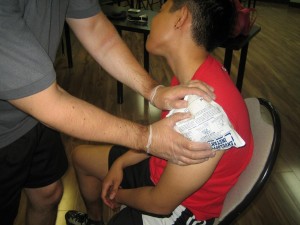Bone spurs that develop in the shoulder occur as a response to chronic stress over an extended period. Based on studies conducted, bone spurs are often asymptomatic and remain undetected until another injury reveals them once an X-ray is taken. This can occur if an individual sustained injuries during a vehicular accident or develop a condition that affects the bones.
It is important to note that bone spurs in the shoulder typically occur in an area where they cause impingement on the rotator cuff tendons, thus the individual experiences pain, inflammation and diminished range of motion.
Measures to reduce the inflammation
The impingement or rubbing of the rotator cuff tendons is called as impingement syndrome. The initial course of treatment for bone spurs in the shoulder typically includes the application of ice applied on the affected area for 20 minutes. This must be done after the individual engages in an activity in order to minimize or prevent inflammation. Using ice on similar injuries can provide relief. By enrolling in a first aid class, you will learn how to effectively use ice on injuries.

The doctor can even recommend the intake of over-the-counter anti-inflammatory medications. Most individuals can greatly benefit if they are given an injection of an anti-inflammatory drug such as cortisone. These cortisone injections are not recommended to be used more than three times in a particular body part since it can cause damage.
Physical therapy
Take note that the anti-inflammatory methods alone are not effective in treating bone spurs in the shoulder. The doctor will usually prescribe a course of physical therapy that spans for 6-8 weeks where the individual is guided by a physical therapist. Certain modalities such as electric stimulation, ultrasound and the application of ice and heat are used to minimize the inflammation. Stretching and massage are also used to increase the flexibility and range of motion of the individual. The last stage of physical therapy is comprised of strengthening movements that are structured to improve the steadiness of the shoulder joint. Take note that the exercise can be specifically tailored to the preferred needs of the individual.
Surgical intervention
The main objective of surgery is to decrease the strain on the rotator cuff. By eliminating the bone spur and providing more space, the individual can move the shoulder freely and with minimal pain. Generally, surgery is performed arthroscopically via small incisions to reduce the degree of secondary trauma. The bone spurs and some of the surrounding bones are removed in order to create a large space for the rotator cuff tendons. The individual will use a splint right after surgery and would undergo physical therapy for 6-8 weeks. Once the range of motion and strength are restored, the individual can resume his/her normal activities as long as clearance was given by the doctor.
